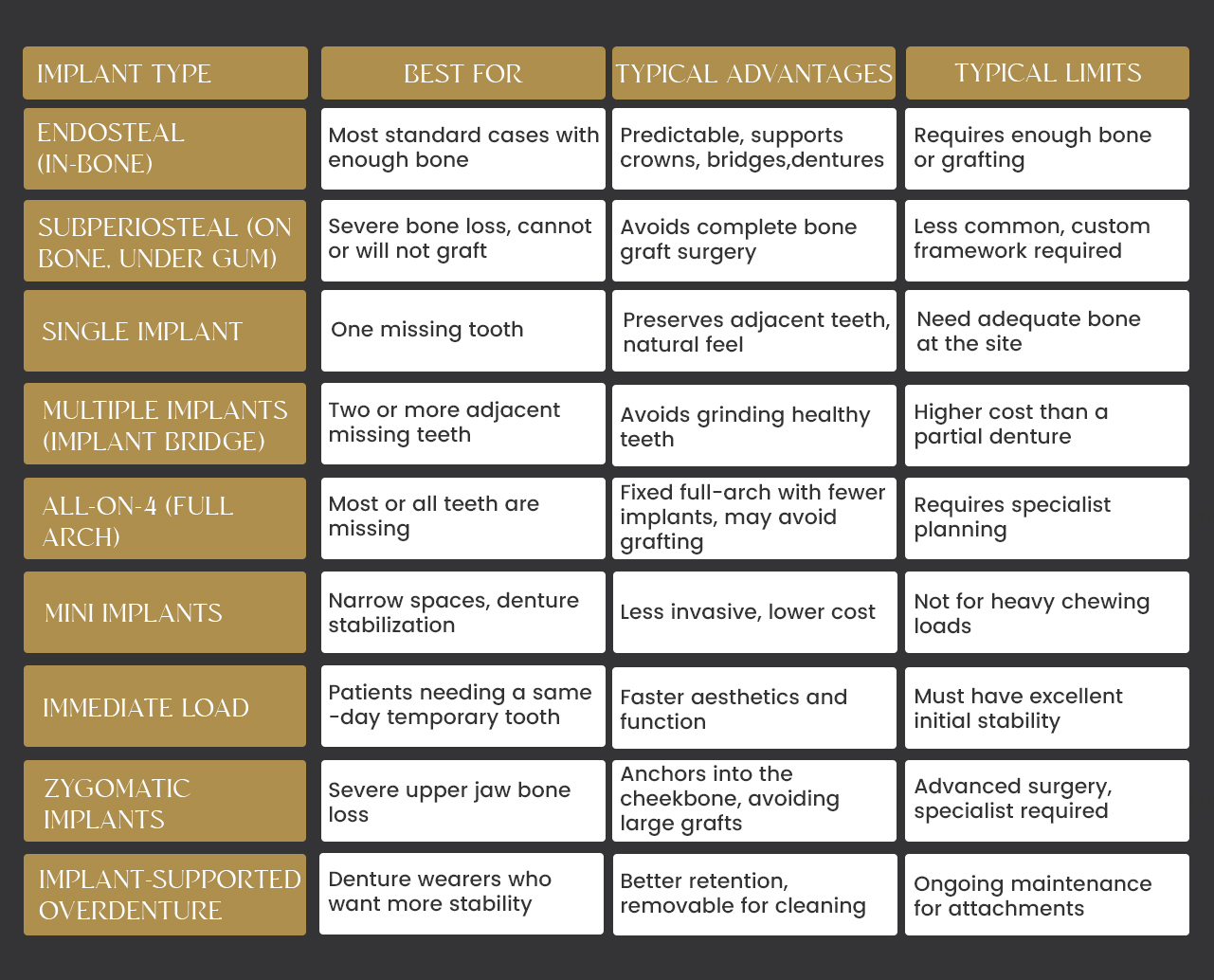Complete Guide To Types Of Dental Implants & Their Suitability


Transform your smile with dental implants—the most predictable solution among all tooth replacement options. They offer exceptional durability, stability, and a natural bond with your jawbone, helping prevent bone loss while preserving facial structure. For luxurious smile care, choose the best dental implants for lasting results, read: What to Expect & How to Prepare for the Procedure?
Bellissima Denta Boutique has curated personalized implant experiences. This guide breaks down useful information about the types of dental implants to make the best decision for luxurious smile care.
Jawbone loss, or bone resorption, is an irreversible process triggered by tooth loss. Without the natural stimulation provided by tooth roots, the jawbone begins to atrophy, weakening its structure, compromising future restorations, and giving the face a sunken appearance.
Adjacent teeth often drift into the empty space, causing loosening, uneven bite pressure, and increasing the risk of periodontal disease and cavities throughout the mouth.
Dental implants replace both the root and crown, preserving bone through biomechanical loading, restoring proper occlusion, and simplifying long-term maintenance and future treatment planning.
Dental implants offer both restorative and cosmetic benefits. They replace missing teeth while enhancing the aesthetics of your smile. These small posts, made of medical-grade titanium or zirconia, are surgically placed to serve as artificial tooth roots.
Because they’re made from highly biocompatible materials, dental implants fuse naturally with the jawbone through a process called osseointegration, creating a stable foundation for crowns, bridges, or implant-supported dentures. This strong bone-to-implant bond helps preserve jawbone volume, maintain facial structure, and restore natural chewing and speech.
For consistent, long-lasting results, a thorough assessment is essential to evaluate bone quality and determine if supplemental procedures are needed. Dental implants are more than just a tooth replacement—they are a cornerstone of full oral restoration. That’s why they should be placed by an experienced surgical team and completed with precise prosthetic design to ensure excellent function and a lifelike appearance.
The missing teeth cause different problems for different individuals. Some might have bone disintegration faster than others, and the number of missing teeth in an individual varies due to age. Different implant types are suited for various problems, so there is no “single solution” for all patients. The optimal selection of the types of dental implants depends on a comprehensive screening to determine the implant goals and objectives.
The most important types are listed below with their suitability and advantages at a glance:

Endosteal implants represent the most widely utilized treatment modality among all types of dental implants, featuring direct intraosseous placement during precision surgical procedures. These endosteal implants utilize grade 4 titanium for superior strength characteristics or advanced zirconia for completely metal-free solutions.
Patients require sufficient bone height and density to achieve primary stability at placement. Endosteal implants rely on strong bone structure for consistent integration success. Osseointegration typically occurs over 3–6 months, providing excellent stability for single crowns, fixed bridges, or full denture systems. Their proven success rates position endosteal implants as the gold standard in modern implant dentistry.
Subperiosteal implants are placed on top of the jawbone beneath gum tissue, offering an alternative among types of dental implants for patients with bone limitations. Custom-fabricated metal frameworks conform to bone contours with posts extending through gums to support replacement teeth.
These subperiosteal implants are ideal for patients lacking sufficient vertical bone height for endosteal placement who cannot undergo bone grafting procedures. This approach eliminates deep bone preparation while providing stable retention. Subperiosteal implants effectively serve patients with significant bone resorption.
Single implants replace individual missing teeth without compromising adjacent healthy tooth structure. These implants use titanium metal posts that fuse with the bone at extraction sites, functioning as artificial roots for one tooth replacement.
Following fusion with the bone, custom abutments and porcelain crowns restore complete function and aesthetics. These prevent tooth migration, maintain proper occlusion, and support natural speech patterns. They are very precise, making them ideal for patients with localized tooth loss who want to preserve surrounding healthy teeth.
Multiple implants efficiently address several consecutive missing teeth through strategic placement. Multiple implants typically involve 2-3 implants supporting fixed bridges, eliminating the need for crown preparation on healthy adjacent teeth.
This approach restores complete chewing function while preserving jawbone health. Multiple implants provide natural aesthetics, distribute occlusal forces appropriately, and protect remaining dentition and periodontal tissues.
All-on-4 dental implants restore complete dental arches using four strategically positioned implants. 2 implants are positioned vertically in the anterior regions, while the other 2 angle posteriorly to maximize bone contact and support in this innovative approach.
This All-on-4 dental implants design frequently eliminates bone grafting requirements and enables immediate loading protocols. Patients transitioning from dentures gain superior stability and enhanced chewing capability. All-on-4 dental implants provide permanent fixation without mobility concerns for complete arch restoration.
Mini dental implants have smaller diameters, making them ideal for patients with reduced bone volume or those seeking minimally invasive procedures. Their placement involves minimal surgical intervention, which shortens recovery time and lessens post-operative discomfort.
These implants effectively stabilize dentures and replace smaller teeth in tight spaces, especially mandibular incisors. Though not ideal for high-stress use, they offer cost-effective solutions for select clinical needs.
Immediate load implants allow same-day prosthetic delivery following surgical placement. Success requires excellent primary stability in dense bone tissue achieved during surgery.
Qualifying patients bypass traditional healing periods and receive immediate aesthetic and functional restoration. This protocol suits patients requiring immediate appearance restoration without extended treatment delays.
Zygomatic implants are different based on their anchorage. They are placed into the cheekbone (zygoma) rather than the maxillary bone. This makes them most suitable for addressing severe upper jaw bone loss. Placing the implants at such an extended length requires advanced surgical expertise.
This technique frequently avoids extensive bone grafting procedures while enabling complete arch restoration in single appointments, even for patients previously deemed unsuitable for conventional implant treatment.
For patients with 2 to 6 implants, implant-supported dentures are recommended to connect them as they offer superior retention compared to conventional dentures. They are offered in fixed and removable configurations to suit patients’ preferences and clinical requirements.
Treatment greatly minimizes denture movement during eating and speaking while maintaining jawbone and facial dimensions. This solution provides a balanced combination of stability, function, and affordability for many patients.
Only a comprehensive evaluation that includes medical history review, general health assessment, and 3D imaging can determine the suitability for the implants. Several factors require careful consideration during the treatment.
Dental implants may be necessary if missing teeth affect your chewing or speech. Tooth loss might seem minor, but it can cause lasting damage, especially with bone loss. Signs you may need implants soon include:
Not all implant cases require supplemental grafting procedures. A sinus lift is necessary in patients with reduced bone height due to resorption. Elevating the maxillary sinus floor is important to support implant stability in the upper jaw.
While other patients who require bone grafting have lost the density and strength of the bone, the synthetic materials address the inadequate bone volume caused by resorption. CBCT evaluation determines the necessity of these supplementary procedures. The recommendations by your dentist are based solely on improving the long-term implant prognosis.
Implant fees vary according to type, quantity, and required preparatory procedures. Initial investment exceeds removable denture costs, yet implants typically require fewer replacements, reducing lifetime treatment expenses.
Bellissima Dental Boutique provides structured payment plans and financing options, ensuring treatment accessibility without compromising clinical excellence.
For patients who have lost one or more teeth, dental implants continue to be the best option for regaining optimal oral function and long-term oral health. Early intervention for treating gaps guarantees much less loss of jawbone and prevents the need for more expensive subsequent surgeries.
We curate your journey through various types of dental implants to achieve confident, naturally beautiful smiles that transform lives. At Bellissima Dental Boutique, we recommend the best implant options that are precisely matched to your individual bone structure, overall health profile, and lifestyle preferences by fusing cutting-edge clinical expertise and personalization.
1. Are dental implants painful?
Discomfort occurs but remains manageable through local anesthesia and prescribed analgesics.
2. How long does healing take?
Complete osseointegration requires 3-6 months. Bone health, age, and individual factors influence accurate timeline predictions.
3. Can smokers receive implants?
Yes, though tobacco use increases failure risk. Smoking cessation before procedures ensures optimal healing.
4. Do all implants need bone grafts or sinus lifts?
No. Most cases proceed without grafting. Supplemental procedures apply only when clinically indicated.
5. How long do implants last?
Proper oral hygiene and regular dental visits enable decades of function, often permanent.
6. Will implants look natural?
High-quality metal/ metal-free restorations receive precise color-matching for seamless integration with surrounding teeth.
We look forward to meeting you.Call Bellissima Dental Boutique at
(910) 778-1229 or request an appointment online to set up your first visit to be our guest. We’ll be in touch soon.